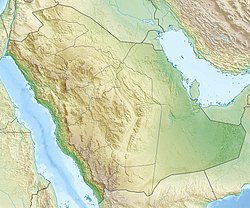
Riyadh is the capital and largest city of Saudi Arabia. It is also the capital of the Riyadh Province and the centre of the Riyadh Governorate. The current form of the metropolis emerged as an offshoot of the eponymous walled town following the dismantling of its defensive fortifications in the 1950s, after which the city underwent several phases of expansion and urbanization.

The House of Saud is the ruling royal family of Saudi Arabia. It is composed of the descendants of Muhammad bin Saud, founder of the Emirate of Diriyah, known as the First Saudi state (1727–1818), and his brothers, though the ruling faction of the family is primarily led by the descendants of Abdulaziz bin Abdul Rahman, the modern founder of Saudi Arabia. It forms a subtribe of the larger prominent ancient Banu Hanifa tribe of Arabia, from which well known 7th century Arabian theologist Maslama ibn Ḥabīb originates. The most influential position of the royal family is the King of Saudi Arabia, an absolute monarch. The family in total is estimated to comprise 10,000 to 20,000 members; however, the majority of power, influence and wealth is possessed by a group of about 2,000 of them. Some estimates of the royal family's wealth measure their net worth at $1.4 trillion.This figure includes the market capitalization of Saudi Aramco, the state oil and gas company, and its vast assets in fossil fuel reserves, making them the wealthiest family in the world and the wealthiest in recorded history.
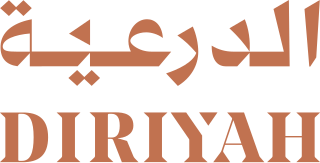
Diriyah, formerly romanized as Dereyeh and Dariyya, is a town and governorate in Saudi Arabia located on the northwestern outskirts of the Saudi capital, Riyadh. Diriyah was the original home of the Saudi royal family, and served as the capital of the Emirate of Diriyah under the first Saudi dynasty from 1727 to 1818. Today, the town is the seat of the Diriyah Governorate—which also includes the villages of Uyayna, Jubayla, and Al-Ammariyyah, among others—and is part of Ar Riyad Province.

Sultan bin Salman Al Saud is a Saudi prince and former Royal Saudi Air Force pilot who flew aboard the American STS-51-G Space Shuttle mission as a payload specialist. He is the first member of a royal family to fly in space, the first Arab to fly in space, and the first Muslim to fly in space, as well as the youngest person ever to fly on the Space Shuttle. On 27 December 2018, he was appointed as chairman of the Board of Directors of the Saudi Space Commission at the rank of minister. He is the eldest surviving son of King Salman.

The Emirate of Nejd or Imamate of Nejd was the Second Saudi State, existing between 1824 and 1891 in Nejd, the regions of Riyadh and Ha'il of what is now Saudi Arabia. Saudi rule was restored to central and eastern Arabia after the Emirate of Diriyah, the First Saudi State, having previously been brought down by the Ottoman Empire's Egypt Eyalet in the Ottoman–Wahhabi War (1811–1818).
Princes' School is a school in Riyadh, Saudi Arabia.

Articles related to Saudi Arabia include:

Saudi Arabia is the second biggest tourist destination in the Middle East with over 16 million visiting in 2017. Although most tourism in Saudi Arabia still largely involves religious pilgrimages, there is growth in the leisure tourism sector. As the tourism sector has been largely boosted lately, the sector is expected to a significant industry for Saudi Arabia, reducing its dependence on oil revenues. This is proved as tourism sector is expected to generate $25 billion in 2019. Potential tourist areas include the Hijaz and Sarawat Mountains, Red Sea diving and a number of ancient ruins.
Muhammad bin Saud Al Muqrin, also known as Ibn Saud, was the emir of Diriyah and is considered the founder of the First Saudi State and the Saud dynasty, which are named for his father, Saud bin Muhammad Al Muqrin. His reign lasted between 1727 and 1765.
The Saudi Heritage Preservation Society (SHPS) is a Saudi charitable society established on 17 May 2010 and concerned with the preservation of national heritage where the constituent meeting was held in the National Museum of Saudi Arabia. It has been registered by UNESCO as an international nongovernmental organization in safeguarding heritage.

The Ministry of Tourism, before 2020 as the Saudi Commission for Tourism and National Heritage (SCTH), till 2015 as the Saudi Commission for Tourism and Antiquities (SCTA) and prior to 2008 as the Supreme Commission for Tourism (SCT), is a government ministry in Saudi Arabia that is concerned with the tourism sector of the country. Established in the year 2000 through a royal decree by King Fahd, it was transformed into a ministry in 2020.
Dalal bint Mukhled Al-Harbi is a Saudi historian known for her research on the history of women and their leadership roles in the Arabian Peninsula. She has been a member of the Saudi Shura Council since January 15, 2013. Al-Harbi has received numerous awards for her contributions, including the King Abdulaziz Book Award in 2019.
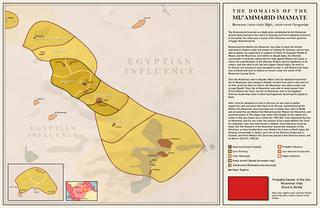
The Mu'ammarid Imamate, also referred to as ibn Muammar's Imamate or Imamate of Diriyah, was a short-lived emirate created after the fall of the first Saudi state. It was based around the city of Diriyah and was briefly a vassal of Muhammad Ali, Ottoman governor of Egypt. The state did not last long, however, as it was reconquered by the Saudis and incorporated into the Second Saudi State.
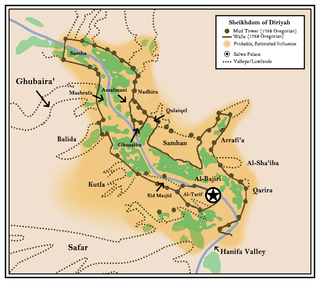
The Sheikhdom of Dir'iyah, was a polity in central Arabia from 1446 to 1744 and the predecessor to the First Saudi State. Its capital was Al-Turaif District, and it was based around the banks of Wadi Hanifa. It was ruled by the Muani'a dynasty from the Durou' clan, and later under its two branches, Muqrin and Watban, with the former becoming the sole house and the house from which the House of Saud descends.

Al-Hukm Palace, also known as the al-ʽAdl Palace, so called from the public square it overlooks from the south, is a historic palace and a popular cultural heritage landmark in the ad-Dirah neighbourhood of Riyadh, Saudi Arabia, located directly opposite to Imam Turki bin Abdullah Grand Mosque in the Qasr al-Hukm District. It is the historic site where tribal leaders and members of the Saudi royal family have been pledging allegiance to the country's political leadership. Built in 1747, it was known as Ibn Dawwas Palace until the 1820s, when Turki bin Abdullah, after gaining control of Najd, shifted the royal family's center of power from Diriyah to the walled town of Riyadh due to the former's severe destruction in a brutal siege during the Ottoman–Wahhabi War of 1818 as well as the town’s Ottoman sacking in 1821.

Saudi Founding Day, officially the Founding Day, is a public holiday in Saudi Arabia celebrated annually on February 22 to commemorate the enthronement of Muhammad bin Saud as the emir of the oasis town of Diriyah in 1727 following the death of his father Saud al-Muqrin, the eponymous ancestor of the al-Saud family. His hereditary succession is considered as the prelude to the inception of the First Saudi State, the antecedent to the Second Saudi State and present-day Kingdom of Saudi Arabia. It was founded in 2022 on its 295th anniversary when King Salman bin Abdulaziz issued a royal decree that designated it as a legal holiday to be observed as per the Gregorian calendar. It is one of the three non-religious national holidays observed in the country, other being the Saudi National Day and Saudi Flag Day.

New Murabba is a planned mixed-use real estate development in northwestern Riyadh and easternmost Diriyah, Saudi Arabia. It was announced in February 2023 by Saudi crown prince Mohammed bin Salman as the world's largest modern downtown project. Named after Riyadh's al-Murabba neighborhood, it is part of Saudi Vision 2030 and would contain the Mukaab, a 400-meters tall cuboid skyscraper. It will be the world's second climate-controlled indoor city, after the Mohammed Bin Rashid City in Dubai, United Arab Emirates.

Museum culture within Saudi Arabia can be traced back to 1945, when the Kingdom participated in the founding of the United Nations Educational Scientific, and Cultural Organisation (UNESCO) and signed the Cultural Treaty of the Arab League which emphasizes, in Article 10, the need to focus on the field of antiquities in the Arab world. Plans for museums began at the first archaeological conferences held by the Arab League Educational, Cultural, and Scientific Organisation (ALESCO).
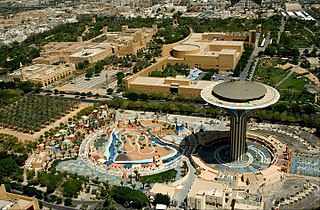
Downtown Riyadh is a term used for a group of 20 neighborhoods in Riyadh, Saudi Arabia. Covering an area of more than 3700 acres, it hosts some of the city's most important cultural and commercial districts, such as the King Abdulaziz Historical Center, the al-Batʼha commercial area and the Qasr al-Hukm District, while simultaneously overlapping with many of the old city areas of the capital metropolis, including the erstwhile walled town. The first downtown development plan was introduced in 2013 by the Royal Commission for Riyadh City.

The walled town of Riyadh was the original core of Riyadh, the modern-day capital of Saudi Arabia, located on the western edge of Wadi al-Batʼha in present-day neighborhoods of ad-Dirah and ad-Doho. It succeeded from Migrin in 1746 when Daham bin Dawwas erected a wall around it, built a palace for himself and ruled as the settlement's chieftain until his overthrow by the First Saudi State in 1773. It was later the center of power of the Second Saudi State for most of 19th century following brief Ottoman presence in Najd. Abdulaziz ibn Saud captured the town in 1902 and made it the base for his 30-year long unification wars that led to the establishment of Saudi Arabia in 1932. The town served as the administrative center of the Saudi government until 1938, when Ibn Saud moved his workplace and residence to Murabba Palace. In 1950, he instructed the dismantling of the fortifications in order to expand the settlement into a metropolis and the walled town eventually ceased to exist. The area covering the perimeters of the erstwhile town was renamed as the Qasr al-Hukm District in 1973 with the aim of preserving its historical and architectural significance.

